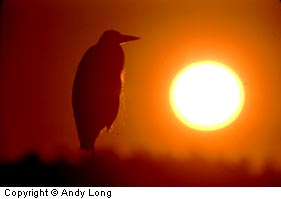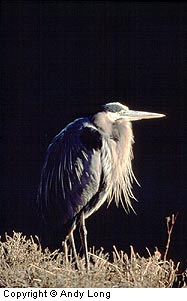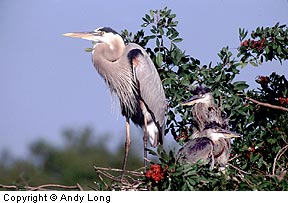
You’re driving down the road of most any wetland area in the country, and you notice something out of the corner of your eye–something standing next to the tall grass at the edge of the water.Upon closer examination, you notice the figure is not more grass but a great blue heron waiting for a meal to swim by.
One of the best, and definitely the most patient,fishers of the animal kingdom, the great blue will stand motionless next to the water for long periods of time in hopes of catching something to eat.I’ve seen one stand in a single spot for more than an hour looking for a fish, frog, or other underwater morsel. Unlike its relative the reddish egret that runs frantically around the water in hopes of spooking up a meal, the stealth-like actions of the great blue heron mark its preferred hunting style.About the only movement you might notice from the great blue when it’s hunting is a slight swaying of its long neck and head from side to side.This action is part of its camouflage since it mirrors the movement of the reeds or tall grass behind it.
Like most wading birds, the great blue is a solitary hunter of the shallows.If you’re lucky enough to be there when one finally does strike its prey, you can take away some interesting images. But, like the bird itself, you have to be ever wary, waiting for the bird to dart its head into the water as it attempts to stab a meal.Depending on what it catches, the great blue will flip its prize into the air, catch it head-first, and swallow it whole.The entire action takes only a few seconds, so you have to be ready.If the heron catches a larger fish, it’ll usually bring it up on shore and slap it against the water or land to stun or kill it before trying to gobble it down its throat.A good show occurs when a great blue catches a snake.It spins its head all over the place trying to force the snake into position to be swallowed.
Hunting photo tips
 If you’re using your automobile as your blind, it’s best to have a window mount.Because great blue herons usually stand in the same spot for long periods of time, you can lock your camera into position and sit with your cable release in hand to wait for action.When the heron starts its move, you can start clicking. If you’ve ever worked great blues that are hunting before, you know they give a very slight hint that they’re about to strike.Just before going for its meal, a great blue will arch its back and neck slightly before diving into the water for the meal.
If you’re using your automobile as your blind, it’s best to have a window mount.Because great blue herons usually stand in the same spot for long periods of time, you can lock your camera into position and sit with your cable release in hand to wait for action.When the heron starts its move, you can start clicking. If you’ve ever worked great blues that are hunting before, you know they give a very slight hint that they’re about to strike.Just before going for its meal, a great blue will arch its back and neck slightly before diving into the water for the meal.
When you first get into position, determine what type of picture you want depending on how much the bird fills your frame.Another factor to keep in mind is its body position in relation to yours.If you want to get it hitting the water and its profile is toward you, then you’ll want to have a horizontal format.If you want it swallowing its prey, then you’ll opt for a vertical. When you’re out of your car and using a tripod, you can use basically the same techniques.If you’re quick enough and your lens allows you to switch from horizontal to vertical easily enough, you might be able to get images of it both hitting the water and swallowing its food. One thing to keep in mind when you’re switching to vertical, allow enough space at the bottom of the frame for the subject’s feet, no matter if they’re underwater or in the grass.Even when you can’t actually see an animal’s feet, to create a satisfying photograph, you need to allow room where the feet must logically be.
If you happen to be in an area such as a rookery where flight shot opportunities are plentiful, great blues are one of the easier birds to capture on film.With its head hunched back between its shoulders and its wing beats slow and deliberate, the great blue lets you get a good lock on it.Because its eye is on the same parallel as its neck, you should try to focus on the neck. It’s easier to spot the neck than the eye, especially when your subject is flying.If you’re anxious to get a shot of a great blue–or most other birds–taking off, notice that they often call out just before taking flight.
Another great feature to look for in heron photography is the breeding plumage of the males during mating season.If you can mange to get the plumage backlit or side lit when the bird is in a profile position, lighting really bring out the details of the feathers. Preening makes a great behavior subject for photography. Great blue herons use their foot to help in this cleaning process.All herons have small serrations on the side of their middle claw.The claws are used to reach places the birds can’t reach with their bills.Special feathers which crumble into powder are rubbed into this claw, and the powder assists cleaning. Powder-forming feathers are also rubbed onto their bill–likewise to aid in preening.
As its hunting style would lead you to believe, herons are primarily solitary animals, except during breeding season. During both times, they’re very territorial, sometimes attacking and killing intruding bird–even other great blue herons. Two times to capture conflict are while they’re hunting and when they’re on the nest.When one is hunting and another great blue tries to claim a spot anywhere in the vicinity, the first one will fly over and chase off the unwanted intruder, even if it lands far enough away so as not to be a hindrance. At a rookery, you’ll notice the territoriality even more.Although nests are close to each other, if another heron comes anywhere near the nest, the occupants will make stabs and loud squawks toward the unwelcome guest.Even the nestlings will join in in letting the other bird know it has come too close.

If great blue herons are such solitary and territorial birds, why do they nest in colonies of up to a thousand nests?One of the theories is that they learn about the productivity of remote feeding sites from other birds in the breeding colonies.And the other birds in these colonies aren’t restricted to great blues. They may include egrets, pelicans, cormorants, and other herons. If you work any of the accessible rookeries, you’ll notice that herons are pirates.If both parents leave a nest at the same time, a nearby bird will be quick to try to steal part of the nest material to enhance its own nest.
If you want a little variety in your great blue heron images, you can venture a little south to Ding Darling in southern Florida and head to the Florida Keys.Here, you can find an all-white morph of the great blue.To make sure you’re seeing a great blue in white phase, look for the dull, yellowish bill and pale legs of the heron.
With great blue herons being the most plentiful of all wading birds in the country, no matter where you go near water, you’ll have a good chance of finding at least one.Probably the most well-known viewing areas are the Venice Rookeryas well as the rookery near St. Augustine, both of which are in Florida,Another major congregating area is the Ridgefield National Wildlife Refuge just north of Vancouver, Washington, where up to four hundred pairs nest in trees on Bachelors Island, making the largest colony in the Pacific Northwest. If you have access to a boat in northern Ohio, you’ll want to venture to West Sister Island, located about nine miles out into Lake Erie from Toledo.Great blues are there year-round, but during nesting season, as many as fifteen hundred pairs have been counted in one of the largest colonies in the country.
By Andy Long

Leave a Reply